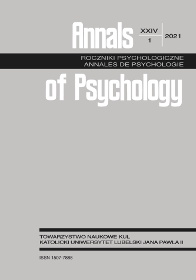The Test of Implicit Attitudes Towards Persons with Visual, Intellectual and Motor Disabilities (IAT-VIMD): A Preliminary Study
The Test of Implicit Attitudes Towards Persons with Visual, Intellectual and Motor Disabilities (IAT-VIMD): A Preliminary Study
Author(s): Paweł KurtekSubject(s): Social Sciences, Psychology
Published by: Towarzystwo Naukowe KUL & Katolicki Uniwersytet Lubelski Jana Pawła II
Keywords: Implicit Association Test; social cognition; dual attitudes; social attitudes towards disabled persons
Summary/Abstract: The implicit attitudes, compared to explicit attitudes moderated by social pressure, play a dominant role in everyday interactions with disabled persons. Therefore, the purpose of the paper is to present the development of Implicit Attitudes Test toward Persons with Visual, Intellectual, and Motor Disabilities (IAT-VIMD). It has been developed to compare the favorization vs devaluation tendency towards non-disabled and disabled adults. We applied photographs showing people in everyday situations to assure spontaneous reactions of the respondents. Ninety-two respondents aged 19–22 years took part in the research. The procedure is based on the IAT (Implicit Association Test) index, developed by Greenwald, McGhee, & Schwartz (1998), i.e. the difference in response time to affective compatible vs non-compatible signals. Statistical analysis confirmed the content validity based on the Competent Judges’ agreement as regards the type of disability, the level of visibility and the level of overall life activity of the object. The external validity was verified with The Conditional Respect for Persons with Disabilities Questionnaire (CRPD-Q) by Kurtek (2018). Next the absolute stability of the test was proved. The presented IAT-VIMD meets the psychometric criteria of content and theoretical validity as well as reliability, and has the potential to become a useful measure of implicit attitudes towards adults with visual, motor and intellectual disabilities in various social groups. The discussion points to the test’s limitations and recommendations for future development and use. In particular, a need for further research on the external validity of the test has been emphasized.
Journal: Roczniki Psychologiczne
- Issue Year: 24/2021
- Issue No: 1
- Page Range: 43-64
- Page Count: 22
- Language: English

